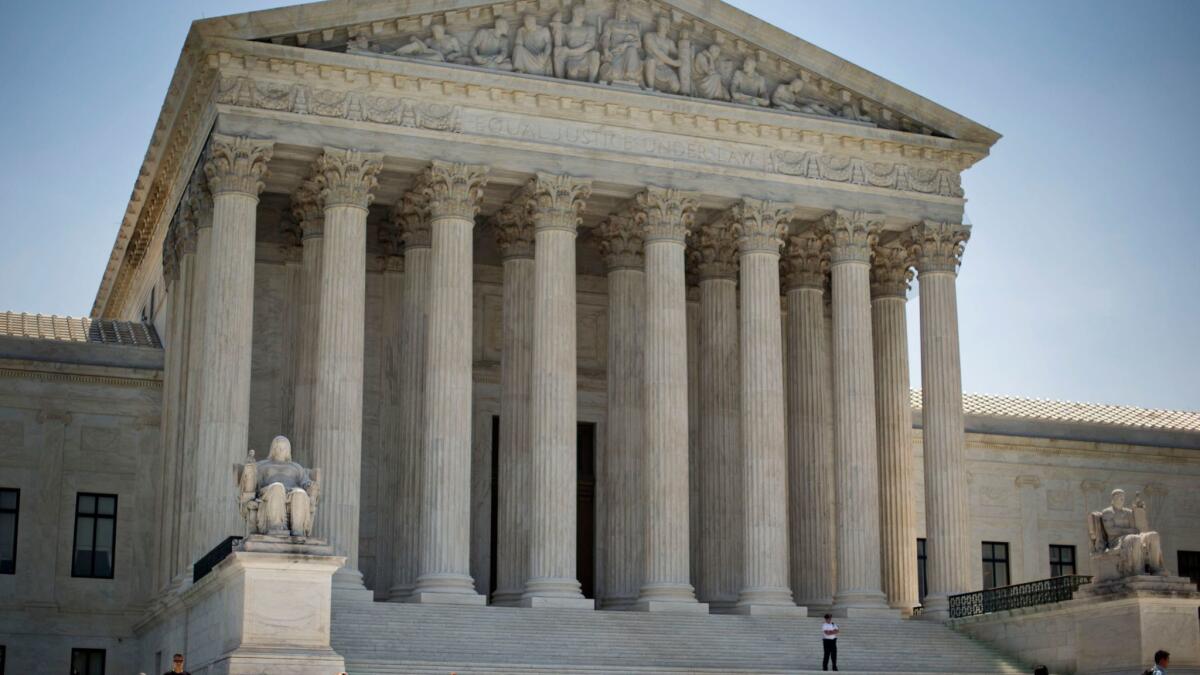Op-Ed: So long Roe vs. Wade? President Trump’s most lasting legacy could be radical change at the Supreme Court

- Share via
The election of Donald Trump as president means that there will be a conservative Supreme Court for years and maybe decades to come, but how much the court will move to the right depends on the health and stamina of Justices Ruth Bader Ginsburg, Anthony Kennedy and Stephen Breyer.
From 1971, when Richard Nixon’s third and fourth justices were confirmed for the court, until February 2016, when Justice Antonin Scalia died, there have been at least five and sometimes as many as eight justices appointed by Republican presidents. Today, there are four justices appointed by Democratic presidents and four appointed by Republican presidents. Chief Justice John Roberts, Justices Clarence Thomas and Samuel Alito are the most conservative; Republican nominee Anthony Kennedy is a swing vote. Ginsburg, Sonia Sotomayor and Elena Kagan are reliable liberals, with Breyer more the centrist.
That lineup won’t change right away. Even if Trump nominates Scalia’s replacement soon after his inauguration on Jan. 20, the process of vetting and hearings means that the court will not have a ninth justice as it hears oral arguments through April. There probably will be a significant number of 4-4 decisions again, particularly in controversial areas like separation of church and state and the scope of federal anti-discrimination laws.
There almost certainly will be a majority to overrule Roe vs. Wade and allow states to prohibit abortions.
There is every reason to believe — or, depending on your politics, to fear — that Trump will nominate a conservative in the mold of Scalia, Thomas and Alito to fill the ninth seat. Trump repeatedly has said that is what he wants to do. He released a list of 21 prospective nominees that included staunch conservatives, such as federal court of appeals Judges Diane Sykes and William Pryor.
For the most part, such an appointee would restore the ideological balance on the court to what it was before Scalia died. But it is important to remember that there were some issues on which Scalia sided with the more liberal justices, such as protecting privacy rights under the 4th Amendment and protecting the right of criminal defendants to confront their accusers under the 6th Amendment. In all likelihood, Scalia’s replacement will be more conservative on these issues.
What happens to the court in the long term depends on when future vacancies occur. Since 1960, 78 is the average age at which justices retire. Scalia was 79 when he died on Feb. 13. There are three justices 79 or older. Ginsburg turned 83 in March. Kennedy turned 80 on July 23. Breyer turned 78 on Aug. 15.
Can these three justices remain on the court until Jan. 20, 2021, assuming that Trump is a one-term president? That will depend on their health and their ability to continue to function at the very high level required of a Supreme Court justice. Of course, if the Democrats take the Senate in 2018 — something that seems unlikely given the election map — they may well refuse to confirm a Republican nominee in 2019, following the precedent set by Senate Republicans with the Scalia vacancy this year.
If even one justice among Ginsburg, Kennedy and Breyer leaves the bench while Trump is in power, there will be a majority for radical changes in constitutional law. Consider some key examples.
There almost certainly will be a majority to overrule Roe vs. Wade and allow states to prohibit abortions. I long have believed that Roberts, Thomas and Alito are definite votes to overrule Roe. Abortion would quickly become illegal in about half the states.
Likewise, there will be a majority to end all affirmative action in the United States. As recently as June, in the decision relating to admission policies at the University of Texas, it was clear that Roberts, Alito and Thomas believe any use of race to benefit minorities to remedy past discrimination and enhance diversity is unconstitutional. Two Trump nominees will give them a majority. This will drastically change the racial composition of colleges and universities.
With two additional conservative justices, the court could also go much further in striking down campaign finance laws, invalidating gun restrictions and allowing much greater government support for religion and religious involvement with government.
Of course, liberals can hope that the new president will appoint justices more in the mold of David Souter than Scalia, or that once on the bench the Scalia replacement will surprise us with his or her rulings. I see little basis for that optimism. Over the last quarter century, presidents have been far more careful to pick justices who reflect and will act on their ideology. Roberts, Alito, Sotomayor and Kagan all have done almost exactly what was expected when they were appointed and confirmed.
A president’s longest lasting legacy is whom he appoints to the Supreme Court and the federal bench. The election of Trump means that there will be a conservative Supreme Court for a long time to come, and it will affect the most important and intimate aspects of our lives.
Erwin Chemerinsky is the dean and a professor at the UC Irvine School of Law.
Follow the Opinion section on Twitter @latimesopinion and Facebook
More to Read
A cure for the common opinion
Get thought-provoking perspectives with our weekly newsletter.
You may occasionally receive promotional content from the Los Angeles Times.









